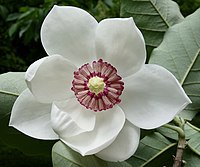
Three unprecedented biphenyl derivatives bearing C6-C3 carbon skeleton from the bark of Magnolia officinalis var. biloba
Sign Up to like & getrecommendations! Published in 2020 at "Chinese Chemical Letters"
DOI: 10.1016/j.cclet.2019.09.058
Abstract: Abstract (±)-Magoilgomer A [(±)-1] and magoilgomer B (2) were identified from the bark of Magnolia officinalis var. biloba. (+)-1 and (−)-1 were a pair of novel biphenyl derivatives featuring three C6-C3 subunits. 2 was an… read more here.
Keywords: magnolia officinalis; biphenyl derivatives; var biloba; bark magnolia ... See more keywords

Isolation and structural elucidation of bioactive obovatol dimeric neolignans from the bark of Magnolia officinalis var. biloba.
Sign Up to like & getrecommendations! Published in 2021 at "Phytochemistry"
DOI: 10.1016/j.phytochem.2021.113020
Abstract: (+)/(-)-Diobolignans A-F, six pairs of enantiomeric obovatol dimeric neolignans, were isolated from the bark of Magnolia officinalis var. biloba. (+)/(-)-Diobolignans A to C possessed a dioxane ring between the benzene ring and the propyl side… read more here.
Keywords: dimeric neolignans; obovatol dimeric; magnolia officinalis; var biloba ... See more keywords

Contact sensitization to Magnolia officinalis bark extract and other allergens in a patient with frontal fibrosing alopecia and lichen planus pigmentosus
Sign Up to like & getrecommendations! Published in 2022 at "Contact Dermatitis"
DOI: 10.1111/cod.14053
Abstract: A woman with Fitzpatrick skin phototype IV and hypothyroidism developed pruritic macular hyperpigmentation with punctate hypopigmentation symmetrically on her forehead (Figure 1A) at age 45 which she related to hair dyes. Gradually, the hyperpigmentation spread… read more here.
Keywords: contact; bark extract; magnolia officinalis; officinalis bark ... See more keywords

Pharmacokinetics and metabolites of glycosides and lignans of the stem bark of Magnolia officinalis in functional dyspepsia and normal rats using LC-MS/MS.
Sign Up to like & getrecommendations! Published in 2022 at "Journal of separation science"
DOI: 10.2139/ssrn.3948395
Abstract: The stem bark of Magnolia officinalis is a traditional Chinese medicine for the treatment of abdominal distention and functional dyspepsia. The pharmacokinetics of three glycosides (magnoloside A, magnoloside B, and syringin) and two lignans (honokiol… read more here.
Keywords: dyspepsia; honokiol magnolol; magnolia officinalis; functional dyspepsia ... See more keywords

Application of Multiple-Source Data Fusion for the Discrimination of Two Botanical Origins of Magnolia Officinalis Cortex Based on E-Nose Measurements, E-Tongue Measurements, and Chemical Analysis
Sign Up to like & getrecommendations! Published in 2022 at "Molecules"
DOI: 10.3390/molecules27123892
Abstract: Magnolia officinalis Rehd. et Wils. and Magnolia officinalis Rehd. et Wils. var. biloba Rehd. et Wils, as the legal botanical origins of Magnoliae Officinalis Cortex, are almost impossible to distinguish according to their appearance traits… read more here.
Keywords: measurements chemical; fusion; magnolia officinalis; tongue measurements ... See more keywords

Novel Therapeutic Approach for the Management of Mood Disorders: In Vivo and In Vitro Effect of a Combination of L-Theanine, Melissa officinalis L. and Magnolia officinalis Rehder & E.H. Wilson
Sign Up to like & getrecommendations! Published in 2020 at "Nutrients"
DOI: 10.3390/nu12061803
Abstract: Mood disorders represent one of the most prevalent and costly psychiatric diseases worldwide. The current therapies are generally characterized by several well-known side effects which limit their prolonged use. The use of herbal medicine for… read more here.
Keywords: magnolia officinalis; combination theanine; mood disorders; effect ... See more keywords

Assessment of the Cytotoxicity, Mutagenicity, and Genotoxicity of Two Traditional Chinese Herbs: Aristolochia baetica and Magnolia officinalis
Sign Up to like & getrecommendations! Published in 2023 at "Toxins"
DOI: 10.3390/toxins15010052
Abstract: Herbal remedies used in traditional medicine often contain several compounds combined in order to potentiate their own intrinsic properties. However, herbs can sometimes cause serious health troubles. In Belgium, patients who developed severe aristolochic acid… read more here.
Keywords: cytotoxicity; aristolochia magnolia; magnolia officinalis; mutagenicity ... See more keywords